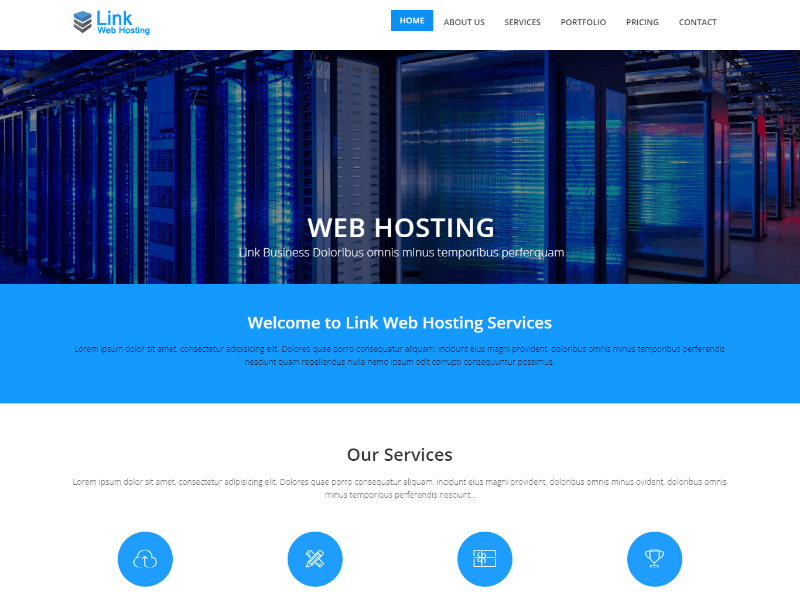Website servers, the unsung heroes of the internet, are the digital engines that power our online experiences. They act as the central hubs where websites reside, waiting to be accessed by users from around the globe. Think of them as digital libraries, storing and delivering all the content that makes up a website, from text and images to videos and interactive elements.
Understanding how website servers function is crucial for anyone interested in web development, online business, or simply appreciating the intricate workings of the internet. From choosing the right hosting provider to optimizing performance and ensuring security, mastering the concepts of website servers unlocks a deeper understanding of the digital world we navigate daily.
Types of Website Servers
Website servers are the backbone of the internet, providing the infrastructure for hosting websites and delivering content to users. Choosing the right server type is crucial for website performance, scalability, security, and cost-effectiveness. This section will explore the different types of website servers and their characteristics.
Physical vs. Virtual Servers
Physical servers are standalone computers dedicated to hosting websites. They offer high performance and control over the server environment. On the other hand, virtual servers, also known as virtual machines (VMs), are software-based simulations of physical servers. They run on a physical host server, allowing multiple virtual servers to share the same hardware resources.
Physical Servers
Physical servers offer several advantages, including:
- High performance: Dedicated hardware resources ensure optimal performance for demanding websites.
- Complete control: Users have full control over the server environment, including operating system, software, and configurations.
- Enhanced security: Physical isolation from other servers reduces the risk of security breaches.
However, physical servers also have some disadvantages:
- High initial cost: Purchasing and maintaining physical servers can be expensive.
- Limited scalability: Scaling up physical servers requires additional hardware, which can be costly and time-consuming.
- Space and power consumption: Physical servers require physical space and consume significant power.
Virtual Servers
Virtual servers offer a cost-effective and flexible alternative to physical servers. Their advantages include:
- Lower cost: Virtual servers share hardware resources, reducing overall costs compared to physical servers.
- Easy scalability: Scaling up or down virtual servers is simple and quick, allowing for flexible resource allocation.
- Simplified management: Virtual server management is typically easier than managing physical servers.
However, virtual servers also have some disadvantages:
- Shared resources: Performance can be affected by other virtual servers sharing the same hardware resources.
- Limited control: Users have less control over the server environment compared to physical servers.
- Security risks: Shared hardware resources can increase the risk of security breaches if not properly managed.
Types of Website Servers
There are various types of website servers, each with its unique features and benefits. Here’s a table comparing different server types:
| Server Type | Cost | Performance | Scalability | Security |
|---|---|---|---|---|
| Shared Hosting | Low | Moderate | Limited | Moderate |
| VPS (Virtual Private Server) | Medium | High | Good | Good |
| Cloud Hosting | Variable | High | Excellent | Excellent |
| Dedicated Server | High | Highest | Excellent | Highest |
Website Server Security

A website server, the heart of any online presence, is vulnerable to various security threats that can compromise data, disrupt services, and damage reputation. It’s crucial to implement robust security measures to protect your website server and safeguard your digital assets.
Common Security Threats
Website servers face a multitude of security threats, ranging from malicious attacks to configuration errors. Understanding these threats is the first step towards effective protection.
- Malware Infections: Viruses, worms, and trojans can infiltrate website servers, stealing data, corrupting files, or launching attacks on other systems.
- Denial-of-Service (DoS) Attacks: These attacks overwhelm a server with traffic, making it unavailable to legitimate users.
- SQL Injection: This technique exploits vulnerabilities in web applications to gain unauthorized access to databases, potentially leading to data theft or manipulation.
- Cross-Site Scripting (XSS): Attackers inject malicious scripts into websites to steal user credentials, hijack sessions, or redirect users to malicious sites.
- Brute-Force Attacks: These attacks involve systematically trying different passwords until a successful login is achieved.
- Misconfigurations: Incorrect server configurations can create security loopholes, making it easier for attackers to exploit vulnerabilities.
Essential Security Measures
To mitigate these threats, implementing comprehensive security measures is essential.
- Strong Passwords and Two-Factor Authentication: Use strong, unique passwords for all server accounts and enable two-factor authentication for an extra layer of protection.
- Regular Security Audits: Periodically assess your server’s security posture to identify vulnerabilities and address them promptly.
- Firewalls and Intrusion Detection Systems (IDS): Deploy firewalls to block unauthorized access and IDS to detect suspicious activity on your server.
- Secure Socket Layer (SSL) Certificates: Use SSL certificates to encrypt communication between your server and users, protecting sensitive data during transmission.
- Regular Backups: Create regular backups of your server data to ensure data recovery in case of an attack or system failure.
- Secure Coding Practices: Develop and maintain secure coding practices to minimize vulnerabilities in web applications.
- Security Monitoring and Logging: Monitor server logs for suspicious activity and promptly investigate any potential security incidents.
Regular Security Updates and Patching
Software vulnerabilities are constantly discovered and patched. Regular updates and patching are crucial for maintaining a secure website server.
“Software vulnerabilities are like cracks in a wall. Attackers exploit these cracks to gain access and wreak havoc. Regular updates and patching are like filling those cracks, strengthening the wall against intrusion.”
- Automated Updates: Configure your server to automatically install security updates whenever they become available.
- Patch Management System: Implement a patch management system to track and manage software updates across your server environment.
- Stay Informed: Stay informed about the latest security threats and vulnerabilities by subscribing to security advisories and newsletters.
Security Protocols and Technologies
Various security protocols and technologies are used to protect website servers.
- Transport Layer Security (TLS): TLS is the successor to SSL and provides encrypted communication between a web server and a web browser.
- Secure Shell (SSH): SSH is a secure protocol for remote login and file transfer, providing encrypted communication between your computer and the server.
- Intrusion Prevention Systems (IPS): IPS actively block attacks, unlike IDS, which only detect them.
- Web Application Firewalls (WAFs): WAFs are designed to protect web applications from attacks such as SQL injection and XSS.
Website Server Performance Optimization
Website server performance is crucial for a smooth and enjoyable user experience. A slow website can lead to frustrated visitors, decreased engagement, and ultimately, lost revenue. Optimizing your website server performance is essential for a successful online presence.
Caching
Caching plays a significant role in improving website server performance. It involves storing copies of frequently accessed website content, such as images, scripts, and stylesheets, in a temporary location closer to users. When a user requests a cached resource, the server can deliver it from the cache instead of retrieving it from the main server. This significantly reduces the time it takes for the content to load, resulting in a faster website.
- Browser Caching: This type of caching stores website content in the user’s browser. When the user revisits the same website, the browser can retrieve the cached content, reducing the need to fetch it from the server. This significantly improves page load times, especially for users who frequently visit the same website.
- Server-Side Caching: This type of caching involves storing website content on the server itself. When a user requests a resource, the server can check if a cached version exists and deliver it directly, bypassing the need to process the request through the entire application stack. This can dramatically improve server performance, especially for websites with high traffic and dynamic content.
Load Balancing
Load balancing is a technique used to distribute incoming traffic across multiple servers. This ensures that no single server becomes overloaded, preventing performance degradation and ensuring a smooth user experience.
- Round Robin: This load balancing method distributes incoming traffic to each server in a sequential order. It is a simple and effective method for distributing traffic evenly across multiple servers.
- Least Connections: This method directs incoming traffic to the server with the fewest active connections. It helps ensure that servers with higher capacity are not overloaded while servers with lower capacity can handle more requests.
Content Delivery Networks (CDNs)
CDNs are networks of geographically distributed servers that store copies of website content. When a user requests a resource, the CDN delivers it from the server closest to the user’s location, reducing latency and improving page load times.
- Reduced Latency: CDNs minimize the distance between users and the server, reducing the time it takes for content to be delivered. This is especially beneficial for users located far from the main server.
- Improved Scalability: CDNs can handle a high volume of traffic, ensuring that website performance remains consistent even during peak hours.
Monitoring and Analyzing Server Performance
Monitoring and analyzing server performance is crucial for identifying bottlenecks and optimizing website performance.
- Server Logs: Server logs provide valuable information about website activity, including user requests, errors, and resource usage. Analyzing these logs can help identify potential performance issues and areas for optimization.
- Performance Monitoring Tools: Various tools are available for monitoring server performance metrics such as CPU usage, memory consumption, and network traffic. These tools can provide real-time insights into server health and help identify potential performance bottlenecks.
Website Server Maintenance
Website server maintenance is crucial for ensuring the smooth operation, security, and performance of your website. Neglecting regular maintenance can lead to various issues, including downtime, security breaches, and slow loading times, ultimately affecting user experience and business operations.
Routine Maintenance Schedule
A well-defined maintenance schedule is essential for proactive server management. Here’s a recommended routine:
- Daily: Monitor server logs for errors and suspicious activity. Run system updates and security patches. Check server resource usage and performance metrics.
- Weekly: Perform a full system scan for malware and vulnerabilities. Clean up temporary files and optimize disk space. Back up critical data and configuration files.
- Monthly: Update software and applications. Review security policies and access controls. Analyze website traffic and performance trends.
- Quarterly: Conduct a comprehensive server audit, including hardware and software checks. Perform load testing to assess server capacity. Update server documentation.
- Annually: Upgrade server hardware if necessary. Re-evaluate security protocols and implement new best practices. Conduct a disaster recovery drill to test backup and restoration procedures.
Importance of Regular Backups and Data Recovery Procedures
Data loss can be catastrophic for any website. Regular backups are essential for protecting your website data and ensuring business continuity in case of unexpected events like hardware failures, software errors, or cyberattacks.
- Types of Backups: Full backups, incremental backups, differential backups.
- Backup Frequency: The frequency depends on the sensitivity of your data and the rate of changes. Daily or even hourly backups are recommended for websites with frequent updates.
- Backup Storage: Store backups in a secure location, preferably off-site, to prevent data loss in case of a disaster.
- Data Recovery Procedures: Develop and test a comprehensive data recovery plan that Artikels steps for restoring data from backups.
Troubleshooting Common Website Server Issues
Troubleshooting website server issues can be challenging, but understanding common problems and their solutions can save time and frustration.
- Slow Website Loading Times: Analyze server logs, check for resource bottlenecks, optimize website code and images, and consider caching solutions.
- Website Downtime: Check server logs for error messages, verify network connectivity, restart services if necessary, and contact your hosting provider for assistance.
- Security Breaches: Update software and security patches, use strong passwords and two-factor authentication, implement a web application firewall, and monitor for suspicious activity.
- Database Errors: Check database logs, optimize database queries, ensure sufficient disk space, and contact your database administrator for support.
Managing Server Resources Effectively
Optimizing server resource usage is crucial for maintaining website performance and preventing overloads.
- Monitor Resource Utilization: Track CPU, memory, disk space, and network bandwidth usage.
- Optimize Website Code: Minimize HTTP requests, compress files, and use efficient coding practices.
- Cache Static Content: Store frequently accessed content in a cache to reduce server load.
- Scale Server Resources: Adjust server resources, such as CPU cores, RAM, and storage, based on website traffic and performance needs.
Website Server Hosting Options

Choosing the right website server hosting option is crucial for your website’s performance, security, and overall success. Different hosting options cater to various needs and budgets, offering varying levels of resources, control, and scalability.
Comparison of Website Server Hosting Options
Different hosting options cater to various needs and budgets, offering varying levels of resources, control, and scalability.
- Shared Hosting: This is the most affordable option, where multiple websites share the same server resources. It’s suitable for small, low-traffic websites with basic requirements.
- VPS Hosting: Virtual Private Server (VPS) hosting provides a virtualized environment on a physical server, offering more resources and control than shared hosting. It’s ideal for websites with moderate traffic and specific needs.
- Dedicated Hosting: This option provides an entire server dedicated solely to your website, offering the highest level of performance, security, and control. It’s suitable for high-traffic websites, e-commerce platforms, or applications requiring significant resources.
Advantages and Disadvantages of Shared, VPS, and Dedicated Hosting
| Hosting Type | Advantages | Disadvantages |
|---|---|---|
| Shared Hosting |
|
|
| VPS Hosting |
|
|
| Dedicated Hosting |
|
|
Factors to Consider When Choosing a Hosting Provider
Choosing the right hosting provider is crucial for your website’s success. Here are some key factors to consider:
- Server Location: Choose a provider with servers located geographically close to your target audience to minimize latency and improve website loading speed.
- Uptime Guarantee: Look for a provider with a high uptime guarantee (99.9% or higher) to ensure your website is available to visitors.
- Customer Support: Reliable customer support is essential for resolving technical issues and getting assistance when needed. Look for providers with 24/7 support options and responsive communication channels.
- Security Features: Choose a provider that offers robust security features, such as firewalls, malware scanning, and SSL certificates, to protect your website from threats.
- Scalability: Select a provider that offers scalable hosting plans to accommodate your website’s future growth and increasing traffic.
- Pricing and Plans: Compare pricing and plans from different providers to find the best value for your needs. Consider factors like bandwidth, storage, and features included in each plan.
Recommendations for Reliable and Reputable Hosting Services, Website server
- Bluehost: Known for its user-friendly interface, affordable plans, and reliable performance.
- HostGator: Offers a wide range of hosting options, including shared, VPS, and dedicated hosting, with excellent customer support.
- SiteGround: Renowned for its fast loading speeds, robust security features, and top-notch customer support.
- GoDaddy: A popular choice for its comprehensive hosting solutions and domain registration services.
- DreamHost: Offers affordable hosting plans with a focus on security and performance.
The Future of Website Servers

The world of website servers is constantly evolving, driven by technological advancements and changing user demands. Understanding these trends is crucial for businesses to optimize their online presence and stay ahead of the curve.
The Impact of Cloud Computing on Website Servers
Cloud computing has revolutionized the way website servers are managed and accessed. Instead of relying on physical infrastructure, businesses can now leverage cloud platforms to host their websites. This shift brings several advantages:
- Scalability: Cloud platforms offer flexible scaling options, allowing businesses to easily adjust server resources based on traffic fluctuations. This eliminates the need for upfront investments in hardware and ensures optimal performance during peak demand.
- Cost-Effectiveness: Cloud services are often more cost-effective than traditional server management, as businesses only pay for the resources they use. This eliminates the overhead associated with hardware maintenance and infrastructure costs.
- Increased Availability: Cloud providers offer high availability and redundancy, ensuring that websites remain accessible even in the event of hardware failures or other disruptions.
Emerging Trends and Technologies in Website Server Infrastructure
The website server landscape is continuously evolving, with new technologies emerging to enhance performance, security, and efficiency. Some of the key trends include:
- Serverless Computing: Serverless computing eliminates the need for server management altogether. Developers can focus on writing code, while the cloud platform handles all server-related tasks. This approach simplifies development and deployment, reduces operational overhead, and enables faster scaling.
- Edge Computing: Edge computing brings processing power closer to users, reducing latency and improving performance. This is particularly beneficial for websites with geographically dispersed user bases or those requiring real-time data processing.
- Containerization: Containerization allows applications to be packaged with all their dependencies, ensuring consistent execution across different environments. This simplifies deployment, reduces compatibility issues, and enhances portability.
- Artificial Intelligence (AI) for Website Optimization: AI-powered tools are increasingly being used to analyze website traffic patterns, optimize performance, and improve security. These tools can identify bottlenecks, predict user behavior, and proactively address potential issues.
Predictions about the Future of Website Server Management
The future of website server management is likely to be characterized by:
- Increased Automation: Automation tools will play a crucial role in simplifying server management tasks, reducing human error, and improving efficiency. This includes tasks like provisioning, monitoring, and security updates.
- Greater Focus on Security: As cyber threats become more sophisticated, website server security will become paramount. Businesses will need to implement robust security measures, including firewalls, intrusion detection systems, and regular security audits.
- Adoption of Green Technologies: Sustainability will become increasingly important in website server management. Businesses will seek to reduce their carbon footprint by adopting energy-efficient hardware and cloud services.
The Evolving Role of Website Servers in the Digital Landscape
Website servers will continue to play a vital role in the digital landscape, but their role is evolving. As more applications move to the cloud, website servers will become increasingly integrated with other technologies, such as:
- Internet of Things (IoT): Website servers will play a key role in connecting and managing data from IoT devices, enabling new applications and services.
- Blockchain Technology: Blockchain technology can be used to enhance website security, improve transparency, and enable new forms of online transactions.
- Virtual Reality (VR) and Augmented Reality (AR): Website servers will be crucial for hosting and delivering VR and AR experiences, providing immersive and interactive content.
End of Discussion
In the ever-evolving landscape of the internet, website servers continue to play a vital role. As technology advances, the demand for faster, more secure, and scalable servers will only grow. By understanding the principles of website server architecture, configuration, and maintenance, individuals and businesses can ensure their online presence remains robust, reliable, and engaging for users worldwide.
Website servers are the backbone of the internet, housing websites and applications. If you need to access a website server remotely, you might find the teamviewer download for pc helpful. TeamViewer allows you to connect to and control another computer, which can be invaluable for managing your website server.




